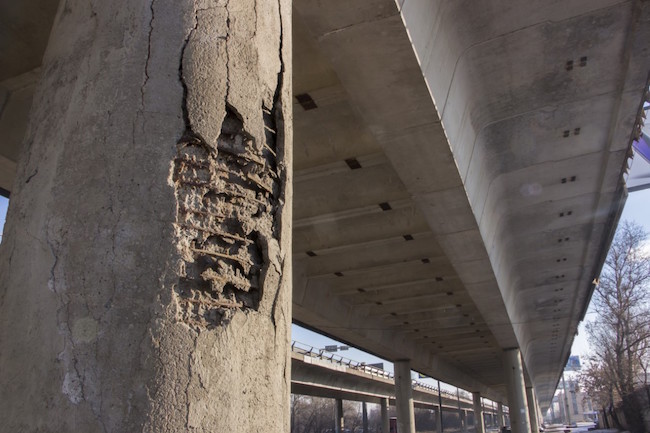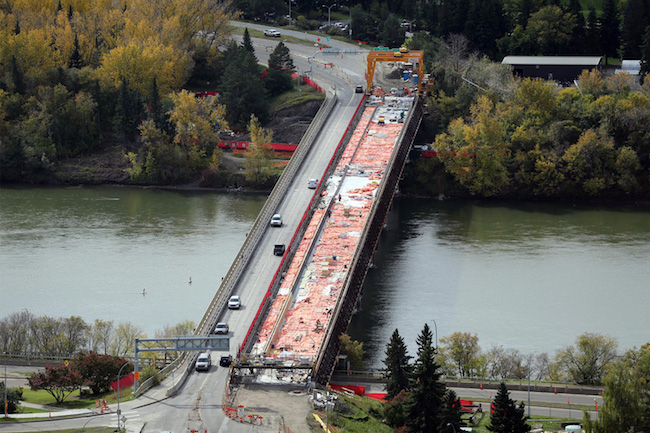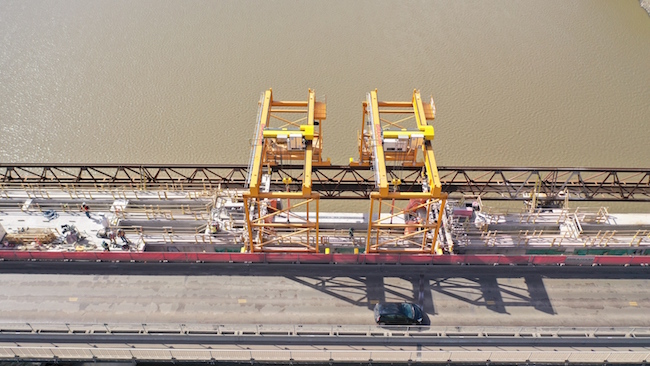
A new lease on life: More bridges entering old age mean more repair and upgrade projects
By David Kennedy
Bridges Concrete
As Canada’s infrastructure ages, the demand for repair projects continues to rise. PHOTO: Adobe Stock/Maykal
It’s no secret that Canada’s population is aging. Fewer kids mean fewer young people, while extended life spans add to the number of seniors. Undeniably, it’s a bit more complicated than that, but the basic arithmetic is clear-cut.
And it’s a similar story for a key category of the country’s infrastructure.
About three-quarters of Canadian bridges were built before 2000. For several classes of bridge — arterial, collector and local — nearly half were built before 1970, according to the latest Canada Infrastructure Report Card, which draws on information compiled by Statistics Canada. Considering the estimated service life of the average Canadian bridge is around 50 years, many are well into old age. Bridges don’t exactly turn grey, but with structures aging far faster than they’re replaced, wear and tear, as well as new load or safety requirements mean the market for repair and upgrade work is taking off.
In 2019, 12 per cent of Canadian bridges were in poor or very poor shape. Another 26 per cent of bridges were in fair condition. It’s worth noting the asset category also includes tunnels, but with just 351 tunnels and some 47,000 bridges coast to coast, bridges make up the vast majority of the tally.
When comparing the figures to the previous report card, the extent of the work needed is manifest. The comparable study issued just three years earlier in 2016 rated only four per cent of Canadian bridges poor or very poor, with another 22 per cent marked as in fair condition.
To keep infrastructure in working order, repairs and upgrades will only become more important in the years ahead.
Daryl Heppner, the general manager at B.C.-based Polycrete says he is seeing more and more bridges being worked on — whether that be deck repairs or retrofits that bring older structures up to new benchmarks.
“Quite often, it’s the age of the structure,” he says. “So water gets into a crack and fluorides from the salts that they throw in the winter get down into the cracks and then attack the reinforcing steel, which causes corrosion of the reinforcing steel and ultimately causes what most people would consider a pot hole but it’s actually a structural delamination.”
This common issue on bridge decks often requires crews to sawcut and jack hammer out the concrete around the corroded bars, sandblast the rebar and fill the gap with high-strength concrete. Coatings are then often applied to protect the repair. For less serious cracking, epoxy injection is a less invasive fix.
Replacing the bearing pads that sit on piers is another common type of repair, Heppner says, though Polycrete’s main focus is on upgrade projects that rely on carbon fibre reinforcement.
“Not all bridges were designed for the loads that they’re carrying nowadays, so we do what we call carbon fibre strengthening to bring up the load capacity of these bridges,” he says.

Work on the Groat Road Bridge in Edmonton. The bridge’s failure to meet Alberta’s requirements for heavy truck loads was among the deficiencies that prompted a repair. PHOTO: Graham Construction/City of Edmonton
Jeewan Khabra, the Structural Strengthening division manager at Polycrete, has worked on a range of repair work coast to coast, as well as structural and seismic bridge enhancement projects. Currently, his focus is on employing fibre reinforced polymer (FRP) composites.
“The use of those lightweight to high-strength tension members supplement the steel that the client or the engineer of record wishes was in that structural element,” he says, adding that employing the composite systems enables his team to change the structural capacity of certain elements of a bridge without touching the rest of the structure.
For instance, instead of adding steel or concrete to a beam or pier to increase its capacity, which often has a cascade effect that mandates upgrades to adjoining components to transfer the additional load, the FRP approach can be more precise.
“It gives you the same structural capacity as the conventional means of adding that steel and concrete, but because it’s lightweight, all I have to do is attack that column or attack that little section of the beam and you’re up to code,” Khabra says.
While costs of the composites haven’t necessarily changed in recent years, Khabra says the savings on time, logistics and other related factors such as lane closures can be substantial, making the approach appealing to governments and other owners.
Along with increases to bridge load ratings, seismic upgrade projects are also increasingly common on Canada’s West Coast, as B.C. addresses the threat earthquakes pose to its infrastructure.
Balraj Mann, the chairman of Polycrete’s parent firm BM Group, is also bullish on the repair market.
“All over the world as the infrastructure ages, there’s more repairs required for regular maintenance,” he says.
While deck repairs and upgrades relying on FRPs are commonplace, in some cases, far more extensive repairs are required.
One such case is an ongoing project in Edmonton to rehabilitate the Groat Road Bridge, which crosses the North Saskatchewan River west of downtown. The four-lane span was built in 1955, and the latest rehabilitation work is expected to extend its lifespan 50 years.

The novel gantry crane system that was used to repair the bridge. PHOTO: Graham Construction/City of Edmonton
Unlike the average repair, essentially the entire superstructure of the Groat Road Bridge is being torn down and replaced. Deck joint issues, problems with the aging bridge’s rocking pier design and its failure to meet Alberta’s design shear requirements for heavy truck loads, were among the list of deficiencies that prompted the project, according to the City of Edmonton. The original concrete piers will remain, with crews patching and sealing damaged areas, as well as strengthening the bases of several of the support structures.
Simply rebuilding the bridge up or downriver was also not an option because of the sensitive environmental and historical surroundings, the city said. To make the work even more challenging, two lanes of traffic needed to remain open during construction to avoid “significant” detours for the roughly 40,000 vehicles that cross the bridge each workday.
Graham Group Ltd. was awarded the $48 million contract to take on the project in 2018 and has spent more than two years on the complex fusion of demolition and reconstruction. Among other steps, the company has employed a new-to-Canada process that utilizes a pair of gantry cranes running on a steel runway that extends across the whole 330-metre bridge.
Dave Moodie, the general manager of CanWest Concrete Cutting and Coring Inc., which worked on the demolition component of the project as a subcontractor, said the project called for a piece-by-piece dismantling of nearly the entire bridge.
“Slab decks were cut out in between each girder throughout the entire length of the bridge, and then we would wiresaw the girders out,” he says.
Run through a series of pulleys, the use of multiple wiresaws on the bridge was another novel aspect to the project, Moodie says.
Among other hurdles, he pointed to the frigid Edmonton winters — with temperatures dropping to as low as -40 C — as major obstacles.
“We did the majority of the cutting in the dead of winter,” he says. “It makes things incredibly difficult. We cut with water, so everything’s got to be cooled with water. Water freezes at below zero. It was extremely challenging in that way.”
Crews finalized work on the western portion of the bridge last fall and shifted to the east side of the structure, starting with demolition, this January. Despite the cold and other uphill climbs, crews are on-track to complete the Groat Bridge project this fall.
With Canadian infrastructure continuing to get on in age, there will be many similar projects to follow.
This article first appeared in the August 2020 issue of On-Site. Read through the complete issue here.




